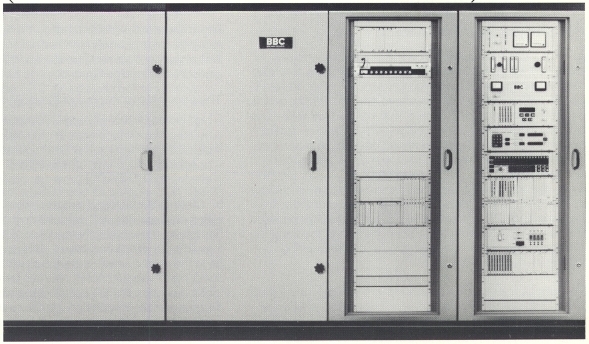| GENERAL DESCRIPTION |
 Introduction
Introduction| TECHNICAL SPECIFICATIONS (Transmitters type SK 53 C3-2P and SK 53 F3-2P) | ||
| Carrier power output | 250 kW over full frequency range | |
| Frequency range | 5.95-21.85 MHz 3.9-26.1 MHz on request Broadcast bands ITU Radio Regulations, Geneva 1982 |
|
| Output impedance | 50 ohms unbalanced 300 ohms balanced (with balun) |
|
| Permissible standing-wave ratio (SWR) | 1:2.0 at 50 ohm output 1:1.7 at 300 ohm output |
|
| Harmonic radiation | The harmonic radiation meets the requirements of the Radio Regulations, Geneva 1982 | |
| Modulation capability | For normal programme service with frequencies between 50 and 5000 Hz with sine-wave modulation Continuous operation with 100% peaks |
|
| AF response at nominal output power with m = 70% and referred to f = 1000 Hz | with f between 60 and 3000 Hz +1 to -1 dB with f between 50 and 5000 Hz +1 to -3 dB |
|
| AF distortion | at nominal output power, m = 90% and f between 50 and 4500 Hz the distortion factor does not exceed 3.5% | |
| Carrier noise level below m = 100% | f = 1000 Hz unweighted: -55 dB | |
| Carrier shift | with sudden application or removal of 100% modulation the variation in the carrier voltage will not exceed 5% | |
| AF input level | for m = 100% modulation across 600 ohms balanced input impedance: 0 dBm - 20 dBm Recommended 18 dBm |
|
| Mains supply | 3-24 kV Permissible voltage fluctuation: ±10% Mains frequency and tolerance (other voltages and frequencies if required): 50 Hz ±2 Hz |
|
| Mains power factor | not less than 0.95 | |
| Overall efficiency (including standard cooling system) a. at 0% modulation b. at 30% modulation c. at 100% modulation d. in programme service |
3.9-15 MHz 71% 71% 71% 71% |
15-26.1 MHz 70% 70% 70% 70% |
| Required time for frequency change | 60 s maximum (C3 version) 3 min approx. (F3 version) |
|
| Specifications may change without notice | ||
| TUBE COMPLEMENT (Transmitters type SK 53 C3-2P and SK 53 F3-2P) | |||
| RF stages | AF stages and modulator | ||
| Number | Type | Number | Type |
| 1 | CQK 350-1 | ||
| 1 | CQL 2-1 | ||
| TECHNICAL SPECIFICATIONS (Transmitters type SK 53 C3-2 and SK 53 F3-2) | ||
| Carrier power output | 250 kW over full frequency range | |
| Frequency range | 5.95-21.85 MHz 3.9-26.1 MHz on request Broadcast bands ITU Radio Regulations, Geneva 1982 |
|
| Output impedance | 50 ohms unbalanced 300 ohms balanced (with balun) |
|
| Permissible standing-wave ratio (SWR) | 1:2.0 at 50 ohm output 1:1.7 at 300 ohm output |
|
| Harmonic radiation | The harmonic radiation meets the requirements of the Radio Regulations, Geneva 1982 | |
| Modulation capability | For normal programme service with frequencies between 50 and 10 000 Hz with sine-wave modulation Continuous operation with 100% peaks |
|
| AF response at nominal output power with m = 70% and referred to f = 1000 Hz | with f between 60 and 7000 Hz +0.5 to -1 dB with f between 50 and 10 000 Hz +1 to -2 dB |
|
| AF distortion | at nominal output power, m = 90% and f between 100 and 5000 Hz the distortion factor does not exceed 3% | |
| Carrier noise level below m = 100% | f = 1000 Hz unweighted: -55 dB | |
| Carrier shift | with sudden application or removal of 100% modulation the variation in the carrier voltage will not exceed 5% | |
| AF input level | for m = 100% modulation across 600 ohms balanced input impedance: 0 dBm - 20 dBm Recommended 18 dBm |
|
| Mains supply | 3-24 kV Permissible voltage fluctuation: with AVR 10%; without AVR 5% Mains frequency and tolerance (other voltages and frequencies if required): 50 Hz ±2 Hz |
|
| Mains power factor | not less than 0.9 | |
| Overall efficiency (including standard cooling system) a. at 0% modulation b. at 30% modulation c. at 100% modulation d. in programme service |
3.9-15 MHz 71% 63% 61% 68-69% |
15-26.1 MHz 70% 62% 60% 66-68% |
| Required time for frequency change | 60 s maximum (C3 version) 3 min approx. (F3 version) |
|
| Specifications may change without notice | ||
| TUBE COMPLEMENT (Transmitters type SK 53 C3-2 and SK 53 F3-2) | |||
| RF stages | AF stages and modulator | ||
| Number | Type | Number | Type |
| 1 | CQK 350-1 | 2 | CQK 50-2 |
| 1 | CQL 2-1 | ||
| THIS TYPE OF TRANSMITTER IS INSTALLED IN THE FOLLOWING COUNTRIES | |||||
| ITU | Country | ITU | Country | ||
| AUS | AUSTRALIA | BEL | BELGIUM | ||
| B | BRAZIL | CAN | CANADA | ||
| EGY | EGYPT | FIN | FINLAND | ||
| IND | INDIA | IRN | IRAN | ||
| IRQ | IRAQ | KRE | KOREA NORTH | ||
| KOR | KOREA SOUTH | KWT | KUWAIT | ||
| MLA | MALAYSIA | HOL | NETHERLANDS | ||
| NIG | NIGERIA | PHL | PHILIPPINES | ||
| POR | PORTUGAL | RRW | RWANDA | ||
| SRL | SIERRA LEONE | SNG | SINGAPORE | ||
| AFS | SOUTH AFRICA | CLN | SRI LANKA | ||
| SUI | SWITZERLAND | TWN | TAIWAN | ||
| TUR | TURKEY | UGA | UGANDA | ||
| USA | USA | ||||